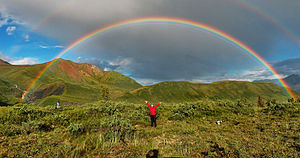
A rainbow is an optical phenomenon caused by refraction, internal reflection and dispersion of light in water droplets resulting in a continuous spectrum of light appearing in the sky.[1] The rainbow takes the form of a multicoloured circular arc.[2] Rainbows caused by sunlight always appear in the section of sky directly opposite the Sun. Rainbows can be caused by many forms of airborne water. These include not only rain, but also mist, spray, and airborne dew.
Rainbows can be full circles. However, the observer normally sees only an arc formed by illuminated droplets above the ground,[3] and centered on a line from the Sun to the observer's eye.
In a primary rainbow, the arc shows red on the outer part and violet on the inner side. This rainbow is caused by light being refracted when entering a droplet of water, then reflected inside on the back of the droplet and refracted again when leaving it.
In a double rainbow, a second arc is seen outside the primary arc, and has the order of its colours reversed, with red on the inner side of the arc. This is caused by the light being reflected twice on the inside of the droplet before leaving it.
- ^ Tony Buick (2010). The Rainbow Sky: An Exploration of Colors in the Solar System and Beyond. Springer Science & Business Media. p. 200. ISBN 9781441910530. Archived from the original on 22 June 2023. Retrieved 28 May 2023.
- ^ "Rainbow". National Geographic. Archived from the original on 20 May 2023. Retrieved 20 May 2023.
- ^ Masters, Jeff (14 April 2005). "The 360-degree Rainbow". Weather Underground. The Weather Company. Archived from the original on 29 January 2015.